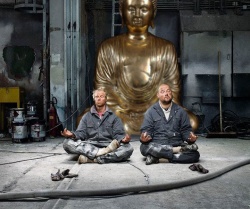Difference between revisions of "Vajraparyankasana"
Jump to navigation
Jump to search
(Created page with "thumb|250px| Vajra-paryanka-asana; (sometimes referred to as Padma-asana or Vajra-asana). The "adamantine throne" position, made with th...") |
|||
| Line 1: | Line 1: | ||
[[File:1bnn18 n.jpg|thumb|250px|]] | [[File:1bnn18 n.jpg|thumb|250px|]] | ||
| − | [[Vajra-paryanka-asana]]; (sometimes referred to as [[Padma-asana]] or [[Vajra-asana]]). The "[[adamantine throne]]" position, made with the {{Wiki|legs}} crossed at the ankles, and both soles of the feet showing, pointed upward. This is the [[posture]] used in [[meditation]] and it is most commonly used to depict the [[enlightened]] [[Buddha]]. The [[historical Buddha]], once he is fully [[enlightened]], will be represented in this [[posture]] when he is seated. | + | |
| + | |||
| + | |||
| + | |||
| + | |||
| + | |||
| + | [[Vajra-paryanka-asana]]; (sometimes referred to as [[Padma-asana]] or [[Vajra-asana]]). The "[[adamantine throne]]" position, made with the {{Wiki|legs}} crossed at the ankles, and both soles of the feet showing, pointed upward. This is | ||
| + | |||
| + | |||
| + | the [[posture]] used in [[meditation]] and it is most commonly used to depict the [[enlightened]] [[Buddha]]. The [[historical Buddha]], once he is fully [[enlightened]], will be represented in this [[posture]] when he is seated. | ||
| + | |||
| + | |||
{{R}} | {{R}} | ||
[http://huntingtonarchive.osu.edu/studypages/internal/dl/SouthAsia/Buddhist/pgs/u1/p3/DL0037Bm.htm huntingtonarchive.osu.edu] | [http://huntingtonarchive.osu.edu/studypages/internal/dl/SouthAsia/Buddhist/pgs/u1/p3/DL0037Bm.htm huntingtonarchive.osu.edu] | ||
[[Category:Asanas]] | [[Category:Asanas]] | ||
{{SanskritTerminology}} | {{SanskritTerminology}} | ||
| + | [[Category:Buddhist Terms]] | ||
| + | [[Category:Buddhism]] | ||
Latest revision as of 14:24, 1 December 2023
Vajra-paryanka-asana; (sometimes referred to as Padma-asana or Vajra-asana). The "adamantine throne" position, made with the legs crossed at the ankles, and both soles of the feet showing, pointed upward. This is
the posture used in meditation and it is most commonly used to depict the enlightened Buddha. The historical Buddha, once he is fully enlightened, will be represented in this posture when he is seated.
